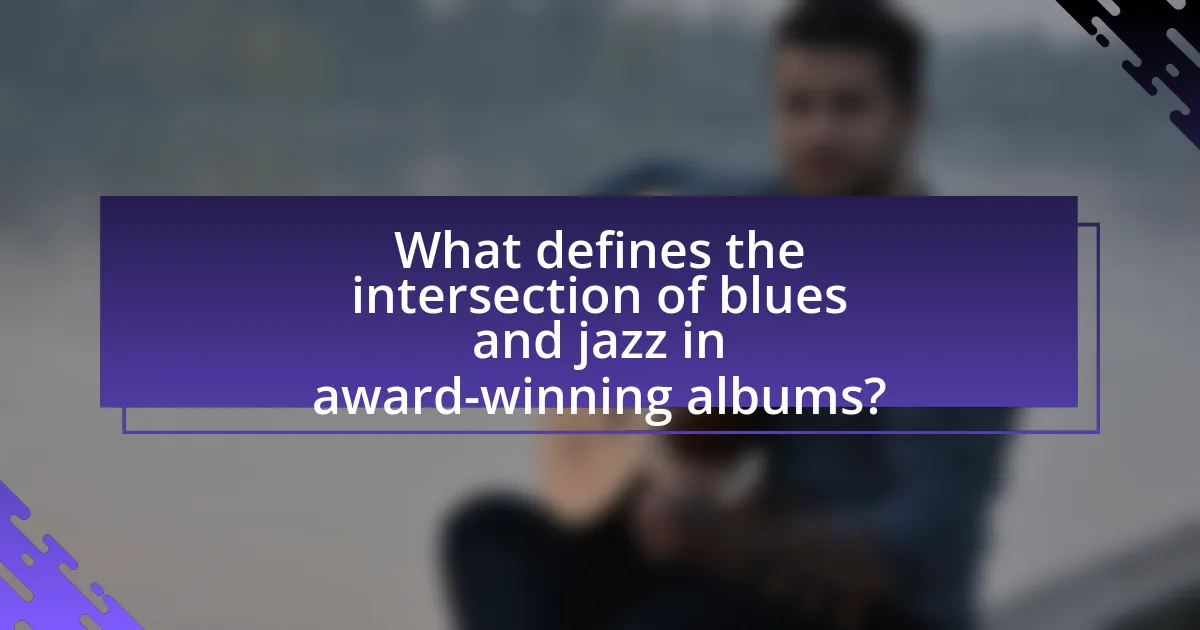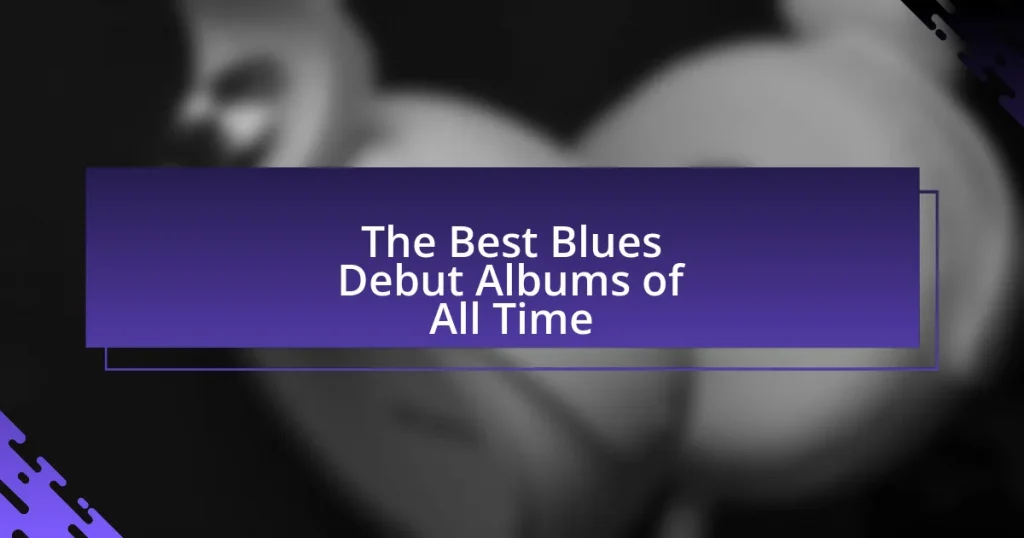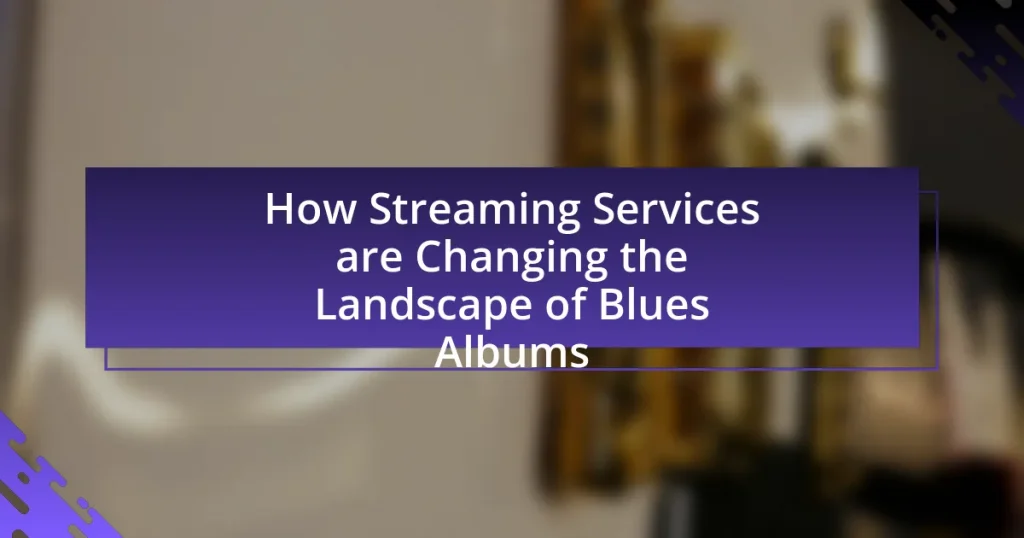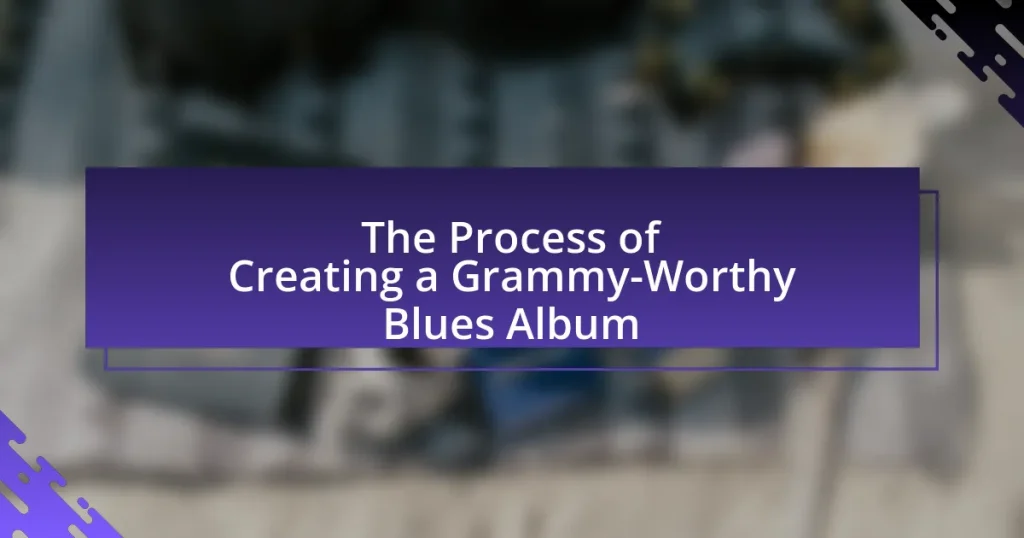The article examines the intersection of blues and jazz in award-winning albums, highlighting how the fusion of emotional expression and improvisational techniques defines this musical blend. It discusses the mutual influence of both genres on compositions, key characteristics of blues and jazz, and the significance of award-winning albums in showcasing their integration. Notable examples include “Kind of Blue” by Miles Davis and “The Blues and the Abstract Truth” by Oliver Nelson, which exemplify the successful merging of these styles. The article also explores the criteria for awards, the impact on artists, and future trends in this evolving musical landscape.

What defines the intersection of blues and jazz in award-winning albums?
The intersection of blues and jazz in award-winning albums is defined by the fusion of emotional expression and improvisational techniques characteristic of both genres. This blend often results in a rich musical tapestry that showcases the soulful storytelling of blues alongside the complex rhythms and harmonies of jazz. Notable examples include albums like “Kind of Blue” by Miles Davis, which incorporates blues elements, and “The Blues and the Abstract Truth” by Oliver Nelson, which merges jazz improvisation with blues motifs. These albums have received critical acclaim and numerous awards, highlighting the successful integration of these two influential musical styles.
How do blues and jazz influence each other in musical compositions?
Blues and jazz influence each other in musical compositions through shared elements such as improvisation, rhythm, and emotional expression. Jazz musicians often incorporate blues scales and chord progressions, which adds a soulful depth to their improvisations. Conversely, blues artists frequently adopt jazz techniques, such as syncopation and complex harmonies, enhancing the richness of their sound. Historical examples include artists like B.B. King, who blended jazz elements into his blues guitar playing, and jazz musicians like Miles Davis, who drew inspiration from the blues to create emotionally resonant compositions. This cross-pollination has led to the development of sub-genres like jazz-blues, showcasing the dynamic interplay between the two styles.
What are the key characteristics of blues music?
Blues music is characterized by its use of specific chord progressions, particularly the twelve-bar blues, expressive lyrics that often convey themes of sorrow and hardship, and a distinctive call-and-response pattern. The twelve-bar blues structure typically involves three chords and is foundational to the genre, allowing for improvisation and emotional expression. Lyrically, blues songs frequently explore personal struggles, love, and resilience, reflecting the experiences of African American communities in the early 20th century. The call-and-response technique, rooted in African musical traditions, enhances the interactive nature of blues performances, making it a communal experience. These characteristics have influenced numerous genres, including jazz, highlighting the interconnectedness of musical styles.
What are the defining features of jazz music?
Jazz music is characterized by its use of improvisation, swing rhythms, and complex harmonies. Improvisation allows musicians to create spontaneous melodies and solos, making each performance unique. Swing rhythms give jazz its distinctive feel, often involving syncopation and a laid-back groove. Additionally, jazz incorporates intricate chord progressions and extended harmonies, which contribute to its rich sound. Historically, these features have evolved through various styles, including bebop and cool jazz, reflecting the genre’s adaptability and cultural significance.
Why are award-winning albums significant in this intersection?
Award-winning albums are significant in the intersection of blues and jazz because they represent the highest level of artistic achievement and innovation within these genres. These albums often showcase the blending of blues’ emotional depth with jazz’s improvisational complexity, resulting in unique musical expressions that resonate with both critics and audiences. For instance, albums like “Kind of Blue” by Miles Davis and “The Thrill Is Gone” by B.B. King have received multiple accolades, highlighting their influence on the evolution of both genres. Such recognition not only elevates the artists’ status but also underscores the cultural importance of this musical fusion, as it reflects the historical and social contexts from which both blues and jazz emerged.
What criteria are used to award albums in the blues and jazz genres?
Albums in the blues and jazz genres are awarded based on criteria such as musical composition, originality, performance quality, production value, and cultural impact. These criteria assess the artistic merit and technical proficiency of the work, with organizations like the Grammy Awards and the Blues Music Awards using specific guidelines to evaluate submissions. For instance, the Grammy Awards consider factors like the overall quality of the recording, the creativity of the artist, and the album’s contribution to the genre, ensuring that only the most exemplary works are recognized.
How do these awards impact the artists and their music?
Awards significantly enhance artists’ visibility and credibility, leading to increased sales and streaming of their music. For instance, winning a Grammy can elevate an artist’s profile, resulting in a 50% increase in album sales within the year following the award. Additionally, awards often provide artists with opportunities for collaborations and performances, further enriching their musical output and expanding their audience reach. This recognition can also influence the direction of their future projects, as artists may feel encouraged to explore new styles or themes that resonate with the acclaim they have received.

What are some notable award-winning albums that exemplify this intersection?
Notable award-winning albums that exemplify the intersection of blues and jazz include “Kind of Blue” by Miles Davis, which won multiple Grammy Awards and is celebrated for its modal jazz influences that resonate with blues elements. Another significant album is “The Blues and the Abstract Truth” by Oliver Nelson, which received critical acclaim and showcases a blend of jazz improvisation with blues motifs. Additionally, “Live at the Apollo” by James Brown, while primarily a soul album, incorporates jazz and blues influences and has been recognized with Grammy Hall of Fame status. These albums illustrate the rich interplay between the two genres, highlighting their shared roots and stylistic connections.
Which albums have received critical acclaim for blending blues and jazz?
Albums that have received critical acclaim for blending blues and jazz include “Kind of Blue” by Miles Davis, “Blues and the Abstract Truth” by Oliver Nelson, and “The Way I See It” by Raphael Saadiq. “Kind of Blue,” released in 1959, is often hailed as one of the greatest jazz albums of all time, incorporating modal jazz elements that resonate with blues influences. “Blues and the Abstract Truth,” released in 1961, features a mix of jazz improvisation and blues structures, showcasing the versatility of both genres. “The Way I See It,” released in 2008, blends contemporary R&B with jazz and blues elements, earning critical praise for its innovative sound. These albums exemplify the successful fusion of blues and jazz, recognized by critics and audiences alike.
What are the standout tracks in these albums?
The standout tracks in the intersection of blues and jazz in award-winning albums include “Crossroads” by Eric Clapton, “Ain’t Nobody” by Chaka Khan, and “Take Five” by Dave Brubeck. “Crossroads” showcases Clapton’s guitar prowess and blues roots, earning critical acclaim and multiple awards. “Ain’t Nobody” blends jazz and funk elements, winning a Grammy Award for Best R&B Performance. “Take Five,” composed by Paul Desmond and performed by the Dave Brubeck Quartet, is a seminal jazz piece that has received numerous accolades, including being inducted into the Grammy Hall of Fame. These tracks exemplify the rich fusion of blues and jazz, contributing to their recognition in the music industry.
Who are the artists behind these influential albums?
The artists behind influential albums at the intersection of blues and jazz include B.B. King, known for “Live at the Regal,” and Miles Davis, recognized for “Kind of Blue.” B.B. King’s album, released in 1965, is celebrated for its powerful guitar work and emotional depth, while Miles Davis’s 1959 album is a landmark in jazz history, showcasing modal jazz and innovative improvisation. Both artists have significantly shaped their respective genres, earning critical acclaim and numerous awards.
How have these albums shaped the perception of blues and jazz?
Award-winning albums have significantly shaped the perception of blues and jazz by blending their elements and showcasing their cultural importance. For instance, albums like “Kind of Blue” by Miles Davis and “The Blues” by various artists have highlighted the improvisational nature of jazz while incorporating blues influences, thus broadening the audience’s understanding of both genres. The critical acclaim and commercial success of these albums have elevated the status of blues and jazz, leading to increased recognition in mainstream music and influencing countless artists across genres. This cross-pollination has fostered a deeper appreciation for the historical roots and emotional depth inherent in both styles, reinforcing their relevance in contemporary music.
What cultural impacts have these albums had on music history?
Award-winning albums that intersect blues and jazz have significantly shaped music history by influencing genres, promoting cultural exchange, and inspiring future artists. For instance, albums like “Kind of Blue” by Miles Davis not only popularized modal jazz but also drew heavily from blues elements, thereby bridging the gap between these two genres. This fusion has led to the emergence of subgenres such as jazz-blues and has encouraged collaborations among artists across different musical backgrounds, fostering a rich cultural dialogue. Additionally, the recognition of these albums in prestigious awards has elevated the status of both blues and jazz, ensuring their continued relevance and evolution in contemporary music.
How do listeners respond to the fusion of these genres in these albums?
Listeners generally respond positively to the fusion of blues and jazz in award-winning albums, appreciating the innovative blend of emotional depth and improvisational skill. This positive reception is evidenced by critical acclaim and commercial success, as many albums that merge these genres have won prestigious awards, such as the Grammy Awards. For instance, albums like “Raising Sand” by Robert Plant and Alison Krauss showcase how the combination of blues and jazz elements can create a rich auditory experience, leading to high listener engagement and favorable reviews. The fusion often resonates with audiences due to its ability to evoke nostalgia while also offering fresh interpretations of traditional sounds.

What are the future trends in the intersection of blues and jazz?
Future trends in the intersection of blues and jazz include a growing fusion of genres, increased collaboration among artists, and the incorporation of technology in music production. This trend is evidenced by award-winning albums that blend traditional blues elements with jazz improvisation, showcasing innovative sounds and diverse influences. For instance, artists like Gary Clark Jr. and Kamasi Washington have successfully merged these genres, leading to a resurgence in popularity and critical acclaim. Additionally, the use of digital platforms for collaboration and distribution is expanding the reach of these blended styles, allowing for a more global audience and new creative possibilities.
How are contemporary artists approaching the fusion of blues and jazz?
Contemporary artists are approaching the fusion of blues and jazz by incorporating elements from both genres to create innovative soundscapes that reflect modern influences. For instance, artists like Gary Clark Jr. and Kamasi Washington blend traditional blues guitar riffs with jazz improvisation, resulting in a unique style that resonates with diverse audiences. This fusion is evident in award-winning albums such as “Black and Blue” by Clark, which showcases blues roots alongside jazz-inspired arrangements, and Washington’s “The Epic,” which features extended improvisational sections that draw from both genres. These artists exemplify how contemporary musicians are redefining the boundaries of blues and jazz, making the fusion relevant in today’s music scene.
What new techniques and styles are emerging in this genre blend?
New techniques and styles emerging in the blend of blues and jazz include the incorporation of polyrhythms and extended improvisation. Artists are increasingly using complex rhythmic structures that draw from African musical traditions, enhancing the depth of both genres. For instance, the use of syncopation and cross-rhythms allows musicians to create a more dynamic interplay between instruments, as seen in recent award-winning albums. Additionally, the fusion of electronic elements with traditional instrumentation is becoming prevalent, allowing for innovative soundscapes that push the boundaries of both blues and jazz. This evolution reflects a broader trend in contemporary music where genre boundaries are increasingly blurred, leading to fresh artistic expressions.
How is technology influencing the creation of blues and jazz music?
Technology is significantly influencing the creation of blues and jazz music by enabling new methods of composition, production, and distribution. Digital audio workstations (DAWs) allow musicians to record, edit, and mix their music with unprecedented precision and flexibility, facilitating innovative soundscapes that blend traditional elements with modern influences. Additionally, advancements in software instruments and plugins provide artists with a vast array of sounds and effects, expanding their creative possibilities. The rise of online platforms for sharing and streaming music has also transformed how blues and jazz artists reach audiences, allowing for greater exposure and collaboration across geographical boundaries. For instance, the use of social media and music streaming services has led to increased accessibility for independent artists, enabling them to share their work without the need for traditional record labels.
What can listeners expect from upcoming award-winning albums?
Listeners can expect a rich fusion of blues and jazz elements in upcoming award-winning albums. These albums are likely to showcase innovative instrumentation, intricate melodies, and emotive storytelling that reflect the deep-rooted traditions of both genres. For instance, artists often blend improvisational jazz techniques with the soulful expressions characteristic of blues, creating a unique sound that resonates with diverse audiences. This intersection has historically led to critically acclaimed works, as seen in past award winners that have successfully merged these styles, highlighting the ongoing evolution and relevance of blues and jazz in contemporary music.
What are some tips for discovering new music that blends blues and jazz?
To discover new music that blends blues and jazz, explore curated playlists on streaming platforms that specifically feature this fusion genre. These playlists often include tracks from artists like Robert Cray and Norah Jones, who are known for their ability to merge elements of both styles. Additionally, attending live music events or festivals that showcase blues and jazz artists can provide firsthand exposure to emerging talents and unique collaborations. Engaging with music communities on social media or forums dedicated to blues and jazz can also lead to recommendations and discussions about new releases that exemplify this blend.
How can fans support artists who are innovating in this space?
Fans can support artists who are innovating in the intersection of blues and jazz by purchasing their music and merchandise, attending live performances, and promoting their work on social media. Purchasing music directly contributes to the artist’s revenue, while attending concerts allows fans to experience the innovation firsthand and provides artists with essential income. Promoting artists on social media increases their visibility, helping them reach a broader audience. According to a 2021 report by the Music Industry Association, direct fan engagement can significantly boost an artist’s career, with 70% of artists reporting increased sales and streaming following social media promotions by fans.



